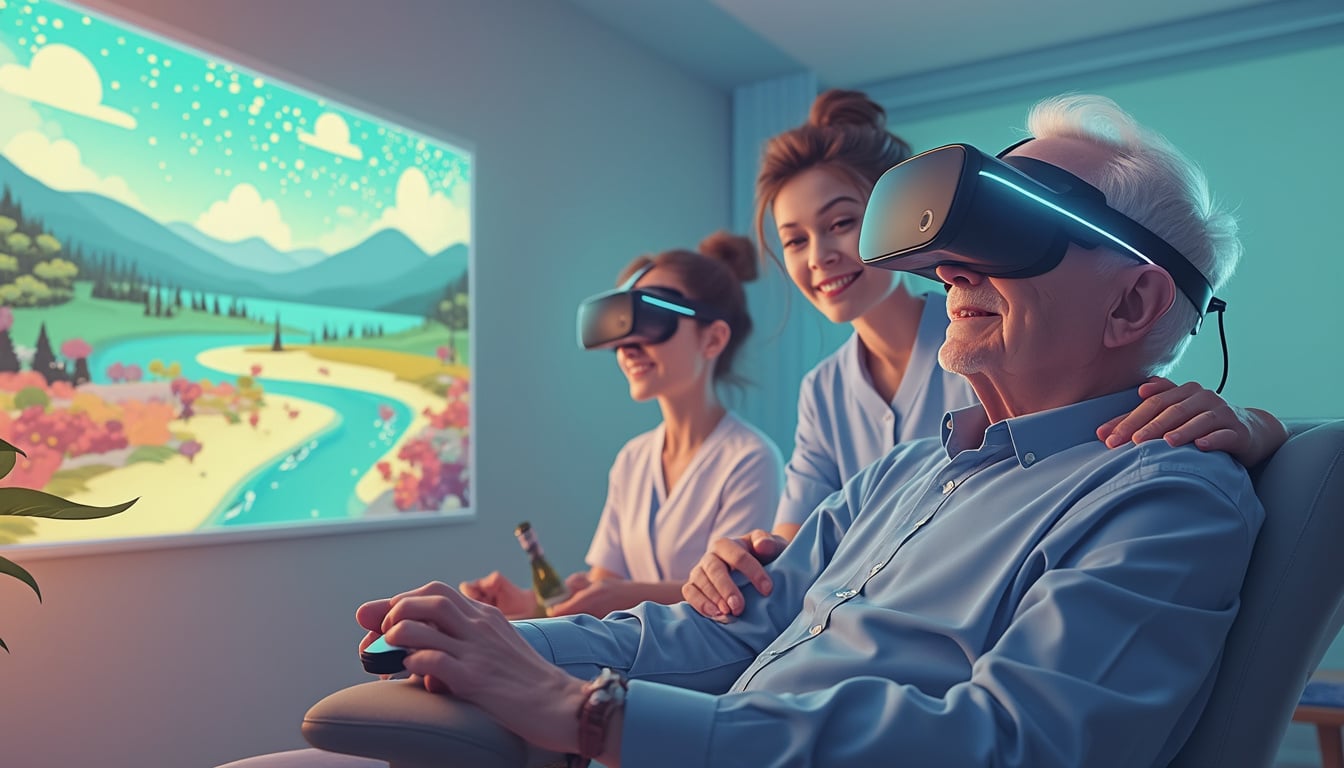Valve is navigating a pivotal moment in gaming history.The departure from virtual reality marks a significant shift for the studio.Fans are abuzz with speculation about what’s next for the iconic developer.
The recent changes at Valve have left the gaming community both excited and curious. With the apparent shelving of VR components in upcoming projects like Project Citadel, questions arise about the future direction of the beloved Half-Life series. Despite stepping back from VR, Valve continues to innovate, hinting at new possibilities that could redefine the gaming landscape. Meanwhile, the legacy of Half-Life: Alyx lingers, showcasing the potential of immersive experiences. As Valve explores fresh avenues, the anticipation for Half-Life 3 grows, keeping fans hopeful for the next chapter. The evolution of Valve’s strategies reflects broader trends in the industry, where adaptability is key. Stay tuned as we delve deeper into what these changes mean for gamers worldwide.
« `html
Valve Corporation has long been a titan in the gaming industry, renowned for iconic franchises like Half-Life and pioneering platforms such as Steam. However, despite the groundbreaking success of Half-Life: Alyx, Valve appears to be stepping back from the realm of virtual reality (VR). This surprising shift has left gamers and industry analysts alike pondering the reasons behind this strategic pivot.
Table of contents
Togglewhat led to the success of half-life: alyx in the vr market?
Half-Life: Alyx, released in March 2020, was a monumental achievement for both Valve and the VR industry. As a prequel to the beloved Half-Life 2, the game leveraged the immersive capabilities of VR to deliver a deeply engaging experience. Critics and players lauded its storytelling, innovative gameplay mechanics, and stunning visual fidelity, solidifying its place as one of the best VR titles ever created.
The success of Half-Life: Alyx was not just a testament to Valve’s dedication to quality but also a significant boost for the broader VR ecosystem. The game showcased the potential of VR storytelling, setting new standards for interaction and immersion. Additionally, the release of the Valve Index VR headset benefited greatly, as it became the preferred hardware for experiencing the game, driving sales and increasing visibility for high-end VR setups.
Moreover, the meticulous attention to detail and the use of advanced technologies in Half-Life: Alyx demonstrated how VR could be used to enhance narrative depth and player engagement. The game’s ability to seamlessly integrate action, puzzle-solving, and exploration within a VR framework was groundbreaking, inspiring other developers to explore similar avenues. This period marked a high point for Valve in VR, making the subsequent shift even more intriguing.
why is valve moving away from vr despite its achievements?
Despite the undeniable success of Half-Life: Alyx, Valve’s apparent retreat from VR raises several questions. One primary factor could be the inherently niche market that VR occupies. While VR has made significant strides, it still represents a smaller segment of the gaming population compared to traditional PC and console gaming. Maintaining and expanding a VR-focused division requires substantial investment, and the returns might not align with broader company goals.
Additionally, technological challenges persist in the VR space. Issues such as motion sickness, hardware limitations, and accessibility barriers continue to hinder mainstream adoption. Valve may be reconsidering the long-term viability of VR as a primary focus area, especially when rapid advancements are necessary to keep up with evolving consumer expectations. The feedback from the VR community, while largely positive for Half-Life: Alyx, also highlighted areas needing improvement, which could influence Valve’s strategic decisions.
Another possible reason is Valve’s diverse portfolio of projects. Balancing multiple initiatives, such as Project Citadel, a cooperative hybrid shooter and RTS set in the Half-Life universe, might lead to a reevaluation of resource allocation. The decision to potentially remove the VR component from Project Citadel suggests a strategic shift towards more traditional gaming experiences, possibly to appeal to a broader audience.
Moreover, internal factors within Valve, such as changes in leadership or company direction, could also play a role. The gaming industry is highly dynamic, and companies often pivot to stay competitive and innovative. Valve’s actions might reflect a broader strategy to diversify their offerings beyond VR, ensuring sustained relevance in an ever-changing market.
how does valve’s shift impact the future of half-life franchise?
The potential scaling back of VR commitments by Valve has significant implications for the future of the Half-Life franchise. Fans have long awaited Half-Life 3, and the enthusiasm generated by Half-Life: Alyx has only heightened expectations. Stepping back from VR could influence the direction of future installments, possibly steering them away from the immersive VR experience that defined Alyx.
Half-Life: Alyx‘s success reignited interest in the franchise, proving that there is still a passionate fanbase eager for new stories within the Half-Life universe. However, if Valve chooses to prioritize other aspects over VR, future games might return to traditional platforms. This decision could either broaden the appeal of upcoming titles or potentially disappoint those who were excited about continued VR integration.
That said, Valve has always been known for its innovative approach. Even if the company steps back from VR, it’s possible that future Half-Life games will incorporate new technologies that align with evolving gaming trends. Whether it’s leveraging augmented reality (AR), advanced AI, or other immersive technologies, Valve’s commitment to pushing boundaries could still keep the franchise relevant and engaging.
Furthermore, Valve’s rich history of storytelling and world-building in the Half-Life series means that any new installment will likely maintain the depth and complexity fans expect. The absence of a strong VR focus doesn’t negate the potential for groundbreaking gameplay and narrative experiences. Instead, it suggests a diversification of how those experiences are delivered, potentially reaching an even wider audience.
what does valve’s retreat mean for the vr gaming industry?
Valve’s decision to step back from VR, despite the triumph of Half-Life: Alyx, sends ripples through the VR gaming industry. As a major player, Valve’s shift could signal a broader trend of reassessment within the sector. Other developers and hardware manufacturers might take cues from Valve’s strategy, potentially leading to a reevaluation of their own investments in VR technologies.
One immediate impact is the potential slowdown in VR innovation. Valve has been instrumental in advancing VR hardware and software, and their reduced focus might create a vacuum that slower-moving competitors could struggle to fill. However, it could also open doors for new entrants to innovate and address the existing challenges in the VR space, such as improving user comfort and accessibility.
Furthermore, Valve’s retreat may influence consumer confidence. While Half-Life: Alyx demonstrated the viability of high-quality VR gaming, Valve’s shift might make consumers hesitant to invest heavily in VR hardware, fearing future support and content scarcity. This could slow down the adoption rate of VR among mainstream gamers, impacting sales of VR headsets and related peripherals.
On the flip side, Valve’s high standards set by Half-Life: Alyx could inspire other developers to elevate their VR offerings. The benchmark set by Alyx might drive the industry to produce more polished and immersive experiences, ultimately benefiting VR gamers. Additionally, Valve’s contributions to VR through OpenVR and support for various hardware platforms continue to benefit the ecosystem, ensuring that VR development remains vibrant and diverse.
what are the alternatives for gamers seeking vr experiences?
For gamers eager to dive into immersive VR experiences after Valve’s apparent retreat, several alternatives continue to thrive. Companies like Oculus (Meta), HTC, and Sony are actively developing and expanding their VR offerings, ensuring a steady stream of new content and hardware innovations.
Pimax, for instance, offers high-resolution headsets that cater to enthusiasts seeking top-tier visual fidelity. Their commitment to leveraging OpenXR standards ensures broader compatibility and flexibility for developers and users alike. Similarly, Meta continues to expand its Quest line, making VR more accessible with wireless options and a growing library of games.
Platforms like SteamVR remain robust, providing a vast ecosystem of games and applications that cater to diverse interests. Titles such as Beat Saber and Superhot VR continue to captivate audiences with their unique gameplay mechanics and engaging content. Additionally, emerging technologies in AR and mixed reality offer new avenues for immersive gaming experiences, broadening the scope beyond traditional VR.
Moreover, indie developers are pushing the boundaries of what VR can offer, creating innovative and niche experiences that cater to specific interests and playstyles. The community-driven nature of VR development ensures that there’s always something new and exciting on the horizon, even as major players like Valve adjust their strategies.
For those concerned about the future of VR content, ongoing advancements in areas like haptic feedback, eye tracking, and wireless technology promise to enhance the overall experience. These innovations aim to make VR more comfortable, responsive, and immersive, addressing some of the long-standing challenges and paving the way for broader adoption.
how will valve’s change influence upcoming vr technologies?
Valve’s strategic pivot away from VR could have profound implications for the development and adoption of upcoming VR technologies. As one of the leading advocates for high-quality VR content and hardware, Valve’s influence extends beyond its own projects. Their decisions can shape industry standards, drive technological advancements, and influence consumer expectations.
One area affected by Valve’s shift is the development of more powerful and user-friendly VR hardware. Valve has been a proponent of high-end headsets like the Valve Index, which set benchmarks for performance and comfort. With Valve potentially redirecting their focus, other companies might have to step up their game to fill the gap, driving innovation to meet the high standards set by Valve’s earlier contributions.
Additionally, Valve’s commitment to open standards like OpenXR ensures interoperability across different VR systems. Even if Valve scales back their VR efforts, their support for open standards continues to benefit the industry by promoting compatibility and reducing fragmentation. This can accelerate the adoption of new VR technologies, making it easier for developers to create cross-platform experiences and for users to access a wider range of content.
Moreover, Valve’s influence on software development tools and ecosystems will persist. Their contributions to platforms like SteamVR provide a robust foundation for future VR applications, enabling developers to build on a solid infrastructure. This ongoing support ensures that VR technology can evolve independently of Valve’s direct involvement, fostering a diverse and dynamic development landscape.
However, Valve’s reduced focus may also slow certain aspects of VR innovation. The company’s resources and expertise have been pivotal in pushing the boundaries of what’s possible in VR. Without their active participation, some areas might experience slower progress, especially those that rely heavily on Valve’s proprietary technologies and research.
Overall, Valve’s strategic changes will likely lead to a more diversified and potentially more competitive VR market. While their direct contributions may diminish, the foundational impact they’ve had on VR technology will continue to influence the industry’s trajectory, ensuring that VR remains a vibrant and evolving field.
where can gamers stay updated on valve’s vr initiatives?
For enthusiasts looking to stay abreast of Valve’s latest moves in the VR space, several resources can provide timely and comprehensive updates. Valve’s official Steam platform remains the primary source for announcements related to their gaming projects and hardware releases. Regular updates and developer blogs offer insights into ongoing and upcoming projects, including any shifts in their VR strategy.
Additionally, gaming news websites like Inverse and Polygon frequently cover Valve’s activities, providing analysis and commentary on their decisions and their impact on the gaming industry. These platforms offer in-depth articles, interviews with industry experts, and reviews that can help gamers understand the broader context of Valve’s actions.
Social media channels, particularly Twitter and Reddit, are also valuable for real-time updates and community discussions. Valve’s official accounts often share news and updates, while subreddit communities like r/Valve and r/half_life provide spaces for fans to discuss and speculate about Valve’s future projects and strategic directions.
Moreover, attending gaming conferences and events, either in-person or virtually, can offer firsthand information on Valve’s latest initiatives. Events like E3, Gamescom, and Valve’s own Steam Game Festival serve as platforms for major announcements and showcases of upcoming technologies and game releases.
For those who prefer more structured updates, subscribing to newsletters from trusted gaming news outlets can ensure a steady stream of curated information. These newsletters often highlight key developments, provide exclusive interviews, and offer expert analysis that can deepen one’s understanding of Valve’s role in the VR landscape.
Ultimately, staying informed requires a combination of regular engagement with official channels, participation in community discussions, and keeping an eye on reputable news sources. By leveraging these resources, gamers can remain well-informed about Valve’s ongoing and future contributions to the virtual reality arena.
what’s next for valve in the gaming world?
As Valve steps back from a heavy focus on VR, the gaming world eagerly anticipates what the company will prioritize next. Valve’s legacy of innovation suggests that their future endeavors will continue to push the boundaries of gaming technology and experiences. Several potential directions could define Valve’s next chapter in the gaming industry.
One plausible avenue is the expansion of cloud gaming services. With the growing popularity of platforms like Google Stadia and Microsoft xCloud, Valve might explore similar technologies to enhance the accessibility and convenience of gaming. Cloud gaming offers players the ability to stream high-quality games without requiring expensive hardware, aligning with trends toward more flexible and user-friendly gaming solutions.
Another potential focus area is the enhancement of the Steam platform. Valve could introduce new features and services to further cement Steam’s position as the premier digital distribution platform for PC gaming. Innovations such as improved social features, enhanced community tools, and better integration with emerging technologies could keep Steam competitive and relevant in an ever-evolving market.
Valve might also continue to delve into game development, leveraging their expertise to create new titles or expand existing franchises. The enduring popularity of franchises like Counter-Strike and Dota 2 suggests that Valve will maintain their commitment to these communities, possibly introducing updates, new content, or entirely new game modes to keep the games fresh and engaging.
Furthermore, Valve’s interest in emerging technologies such as augmented reality (AR) and artificial intelligence (AI) could shape their future projects. By integrating AI-driven features and AR elements into their games, Valve has the potential to create novel and immersive experiences that differentiate their offerings from competitors.
Collaborations and partnerships with other tech companies might also feature prominently in Valve’s strategy. By working with hardware manufacturers, software developers, and other industry players, Valve can leverage collective expertise to innovate and bring new products to market more effectively.
In essence, while Valve’s retreat from VR marks a notable shift, their future in the gaming world remains promising. With a history of adaptability and a reputation for excellence, Valve is poised to continue shaping the gaming landscape, whatever direction they choose to take next.














